Multisensory Coding of Red and Blue in Interior Design for Older Adults and Visually Impaired Users: An Inclusive Design Perspective
Abstract
1. Introduction
2. Materials and Methods
2.1. Identifying the Impact of Color on Emotions
2.2. Interior Design and Multisensory Design in Research
2.2.1. Links Between Color and Sound Perception
2.2.2. Links Between Color and Aroma Perception
2.2.3. Links Between Color and Taste/Flavour Perception
2.2.4. Links Between Color and Touch Perception
2.3. Multisensory Color Coding for Blind, Visually Impaired, and Elderly Users
2.4. Color Perception in Older Adults: Seeing Red and Blue in the Built Environment
Literature Review: 2015–2025
2.5. Symbolism and Perception of Red and Blue
3. Results
3.1. General Emotional Patterns Associated with Color
3.2. Interior Design and Multisensory Design
- (1)
- Visual–aesthetic—including novelty, appropriateness of color schemes, order, and richness of form;
- (2)
- Functional—referring to usability, comfort, and privacy;
- (3)
- Individual—related to personalization, fashion, and the incorporation of cultural elements.
3.3. Multisensory Color Coding for the Blind, Visually Impaired, and Elderly
3.4. Links Between Color and Aroma Perception
3.5. Links Between Color and Tactile Perception
3.6. Survey on Multisensory Associations of Red and Blue
3.7. The Contrast Between Red and Blue as a Literary Paraphrase of Narrative Tension in Solaris
4. Discussion
4.1. Multisensory Perception of Color: Vision, Sound, Smell, Touch, and Temperature
4.2. Challenging Assumptions: Color, Temperature, and Synesthesia
4.2.1. Synesthesia and Applications in Design
Sustainable and Inclusive Color Design
4.3. Conceptual Prototypes of Multisensory Light Switches
4.4. Color, Perception, and the Purkinje Effect
5. Conclusions
Author Contributions
Funding
Institutional Review Board Statement
Informed Consent Statement
Data Availability Statement
Acknowledgments
Conflicts of Interest
References
- Xie, C.; Zhang, Z.; Guo, Y. Multisensory Experience and Emotional Response in Architectural Space: A Comparative Analysis of a Coffee Roasting Factory. Buildings 2023, 15, 1393. [Google Scholar]
- Ziat, M.; Balcer, C.A.; Shirtz, A.; Rolison, T. A Century Later, the Hue-Heat Hypothesis: Does Color Truly Affect Temperature Perception? In Haptics: Perception, Devices, Control, and Applications; Springer: Berlin/Heidelberg, Germany, 2016; pp. 273–280. [Google Scholar] [CrossRef]
- Jonauskaite, D.; Mohr, C. Do we feel colours? A systematic review of 128 years of psychological research linking colours and emotions. Psychon. Bull. Rev. 2025, 32, 1457–1486. [Google Scholar] [CrossRef]
- Jonauskaite, D.; Abu-Akel, A.; Dael, N.; Oberfeld, D.; Abdel-Khalek, A.M.; Al-Rasheed, A.S.; Antonietti, J.-P.; Bogushevskaya, V.; Chamseddine, A.; Chkonia, E.; et al. Universal patterns in color–emotion associations are further shaped by linguistic and geographic proximity. Psychol. Sci. 2020, 31, 1245–1260. [Google Scholar] [CrossRef]
- Takei, S.; Imaizumi, S. Effect of background color on facial emotion recognition: Influence of color–emotion associations. i-Perception 2022, 13, 1–16. [Google Scholar]
- Alvarado, J. Text-to-image models reveal specific color-emotion associations. Front. Psychol. 2025, 16, 1593928. [Google Scholar] [CrossRef] [PubMed]
- Bower, T.; Kim, J.; Kim, H. Influence of immersive room color on physiological and psychological responses in virtual reality. Front. Psychol. 2022, 13, 879325. [Google Scholar]
- Wang, M.-Y.; Ku, Y.-C.; Lin, Y.-H. Changes in color preference and emotional associations during the COVID-19 pandemic. Front. Psychol. 2024, 15, 1365332. [Google Scholar]
- Rui, L.; Firzan, M. Emotional Design of Interior Spaces: Exploring Challenges and Opportunities. Buildings 2025, 15, 153. [Google Scholar] [CrossRef]
- Spence, C. Senses of place: Architectural design for the multisensory mind. Cogn. Res. Princ. Implic. 2020, 5, 46. [Google Scholar] [CrossRef]
- Sandmann, P.; Dillier, N.; Eichele, T.; Meyer, M.; Kegel, A.; Pascual-Marqui, R.D.; Marcar, V.L.; Jäncke, L.; Debener, S. Visual activation of auditory cortex reflects maladaptive plasticity in cochlear implant users. Brain 2012, 135, 555–568. [Google Scholar] [CrossRef]
- Miyamoto, K.; Taniyama, Y.; Hine, K.; Nakauchi, S. Congruency of color–sound crossmodal correspondence interacts with color and sound discrimination depending on color category. i-Perception 2023, 14, 1–18. [Google Scholar] [CrossRef]
- Bartulienė, R.; Saudargienė, A.; Reinytė, K.; Davidavičius, G.; Davidavičienė, R.; Ašmantas, Š.; Raškinis, G.; Šatkauskas, S. Voice-Evoked Color Prediction Using Deep Neural Networks in Sound–Color Synesthesia. Brain Sci. 2025, 15, 520. [Google Scholar] [CrossRef] [PubMed]
- Cho, J.Y.; Suh, J. Spatial Color Efficacy in Perceived Luxury and Preference to Stay: An Eye-Tracking Study of Retail Interior Environment. Front. Psychol. 2020, 11, 296. [Google Scholar] [CrossRef] [PubMed]
- Ward, R.J.; Ashraf, M.; Wuerger, S.; Marshall, A. Odors modulate color appearance. Front. Psychol. 2023, 14, 1175703. [Google Scholar] [CrossRef]
- Spence, C.; Levitan, C.A. Exploring the Role of Color in Flavor Perception: Recent Advances and Future Directions. Food Qual. Prefer. 2021, 92, 104124. [Google Scholar]
- Reinoso Carvalho, F.; Wang, Q.J.; Spence, C. Assessing the Influence of Beer Color, Bottle Color, and Label Design on Consumer Expectations and Perceptions. Food Res. Int. 2021, 141, 110074. [Google Scholar]
- Tu, Y.; Yang, Y.; Ma, M. Effect of Ambient Color on Taste Perception and Emotional Response. Appetite 2020, 149, 104630. [Google Scholar]
- Wang, Z.-Y.; Cho, J.-Y. Older Adults’ Response to Color Visibility in Indoor Residential Environment Using Eye-Tracking Technology. Sensors 2022, 22, 8766. [Google Scholar] [CrossRef]
- Chen, Y.C.; Spence, C. Crossmodal Correspondences between Basic Tastes and Colors: A Replication and Extension Study. Multisens. Res. 2023, 36, 1–20. [Google Scholar]
- Ho, H.-N.; Iwai, D.; Yoshikawa, Y.; Watanabe, J.; Nishida, S. Combining colour and temperature: A blue object is more likely to be judged as warm than a red object. Sci. Rep. 2014, 4, 5527. [Google Scholar] [CrossRef]
- Ludden, G.D.; Schifferstein, H.N.; Hekkert, P. The multisensory perception of products: The influence of color–texture congruence. Des. Stud. 2020, 68, 100943. [Google Scholar]
- Wastiels, L.; Schifferstein, H.N.J.; Wouters, I. Materiality matters: The influence of color and gloss on perceived material properties and touch expectations. Front. Psychol. 2021, 12, 624303. [Google Scholar]
- Hagtvedt, H.; Brasel, S.A. Crossmodal correspondences between visual and tactile textures: The role of color. J. Consum. Psychol. 2022, 32, 482–495. [Google Scholar]
- Ward, J.; Simner, J. The color of touch: A case of tactile–visual synaesthesia. Neurocase 2012, 18, 167–180. [Google Scholar] [CrossRef] [PubMed]
- Iranzo Bartolomé, J.; Cho, G.; Cho, J.-D. Multi-Sensory Color Expression with Sound and Temperature in Visual Arts Appreciation for People with Visual Impairment. Electronics 2021, 10, 1336. [Google Scholar] [CrossRef]
- Xu, H.; Zhao, J.; Jin, C.; Zhu, N.; Chai, Y. Research on the Multi-Sensory Experience. Design of Interior Spaces from the Perspective of Spatial Perception: A Case Study of Suzhou Coffee Roasting Factory. Buildings 2025, 15, 1393. [Google Scholar] [CrossRef]
- Jaglarz, A. Color as a Key Factor in Creating Sustainable Living Spaces for Seniors. Sustainability 2024, 16, 10251. [Google Scholar] [CrossRef]
- Jiang, A.; Fang, W.; Liu, J.; Foing, B.; Yao, X.; Westland, S.; Hemingray, C. The effect of colour environments on visual tracking and visual strain during short-term simulation of three gravity states. Appl. Ergon. 2023, 110, 103994. [Google Scholar] [CrossRef]
- Wang, Q.J.; Spence, C. “That’s What I Call Umami!” Color–Taste Associations in Children and Adults. J. Sens. Stud. 2022, 37, e12736. [Google Scholar]
- Anstis, S.M. The Purkinje rod–cone shift as a function of luminance and retinal eccentricity. Vis. Res. 2002, 42, 2485–2491. [Google Scholar] [CrossRef]

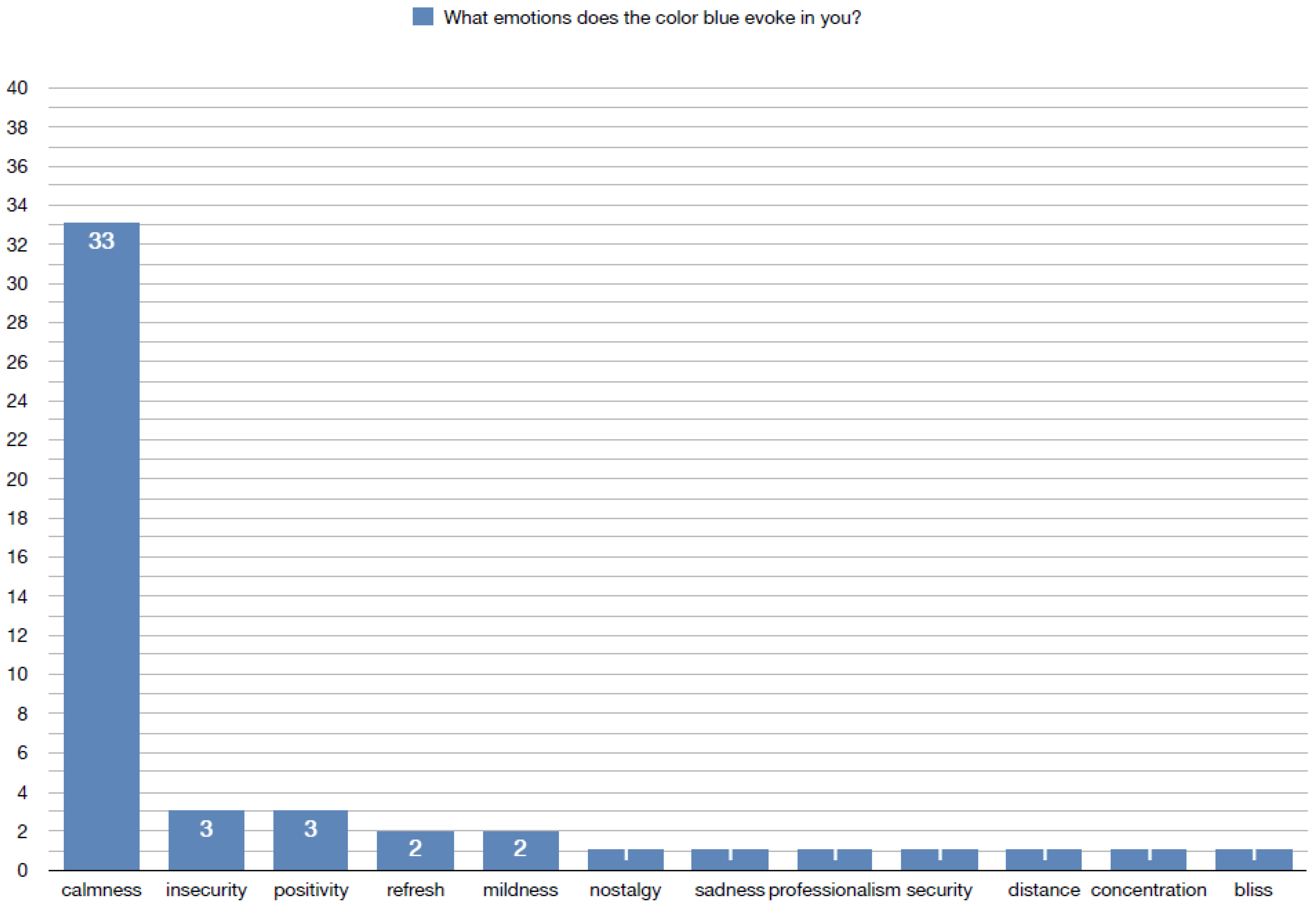


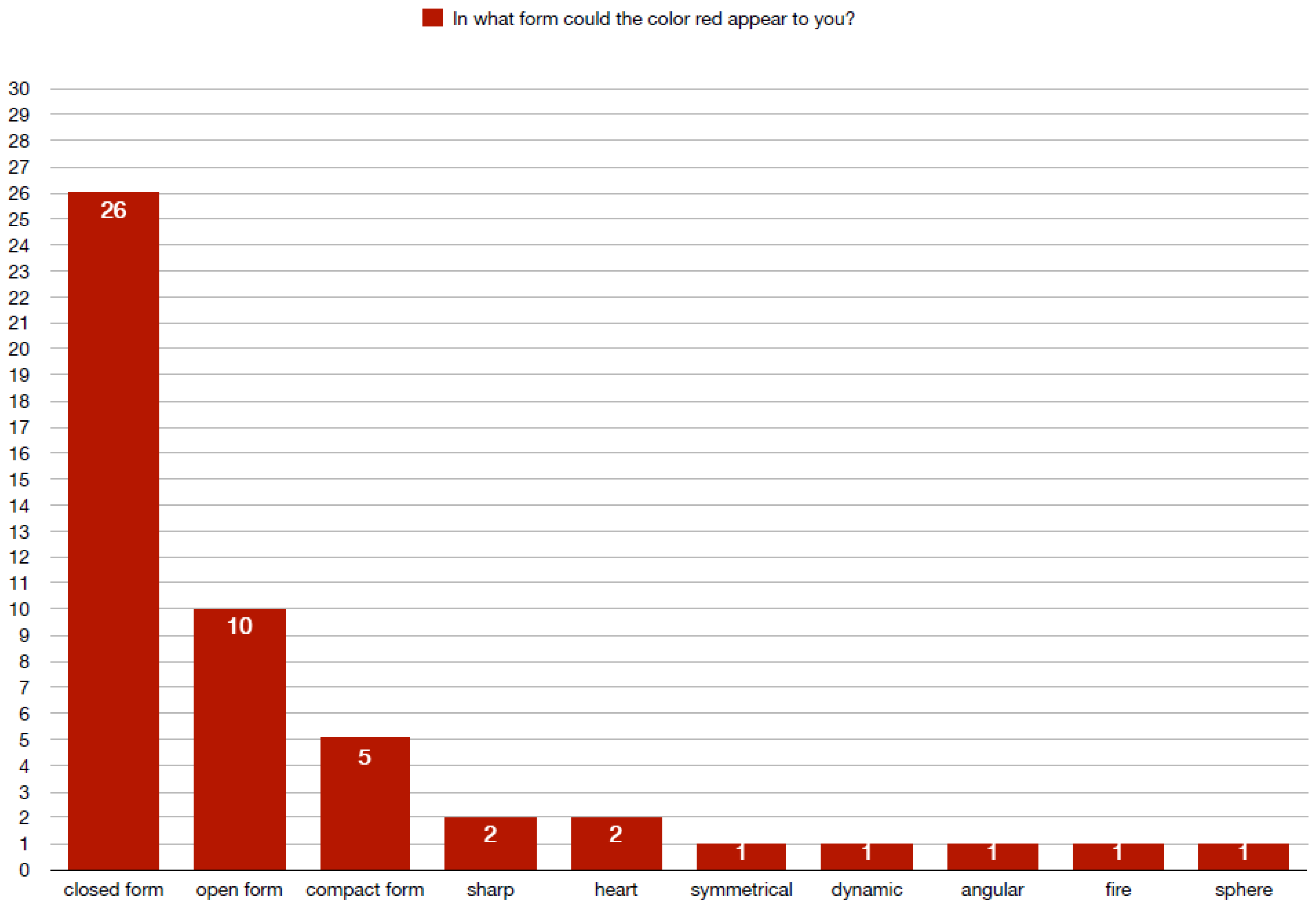
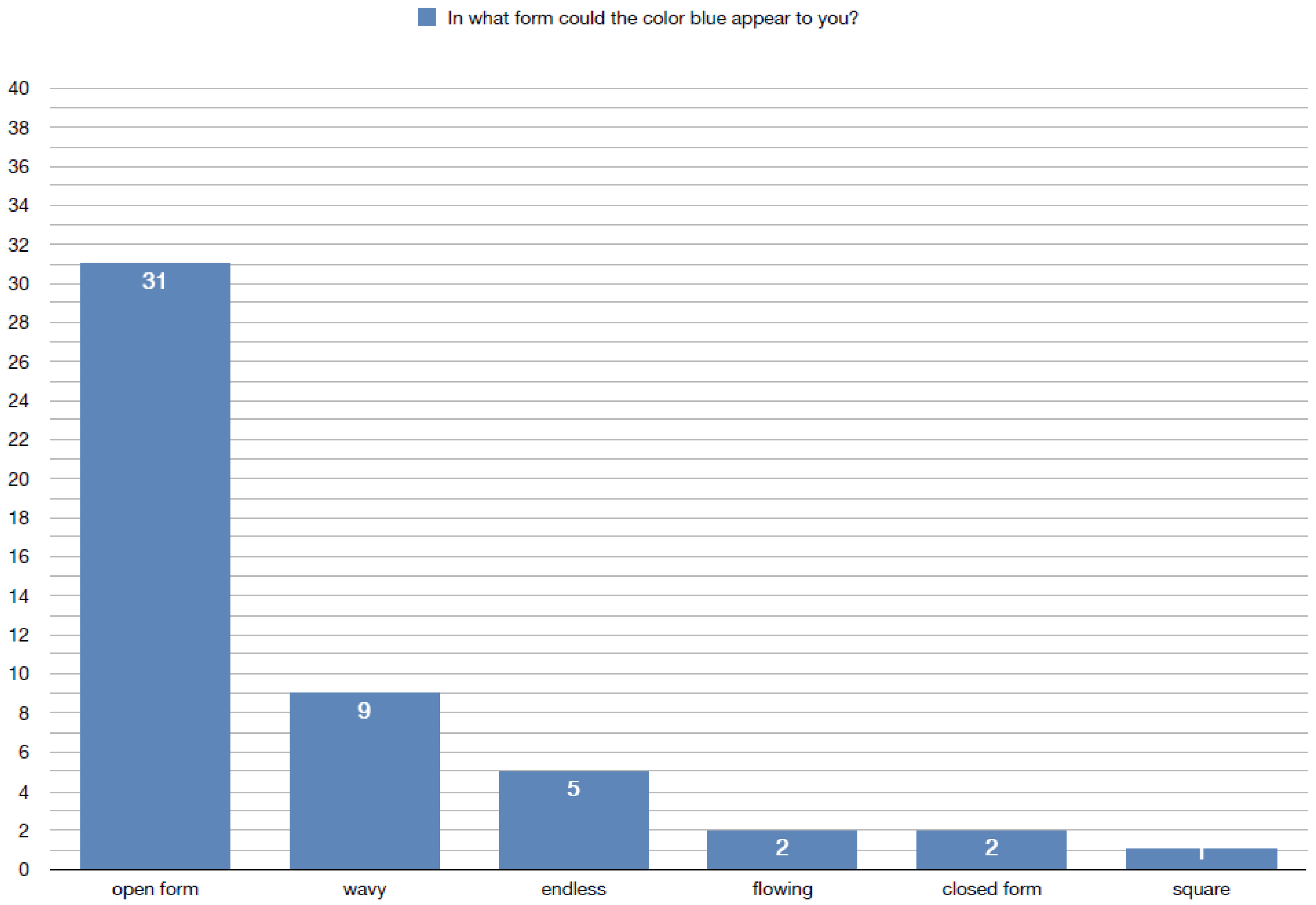
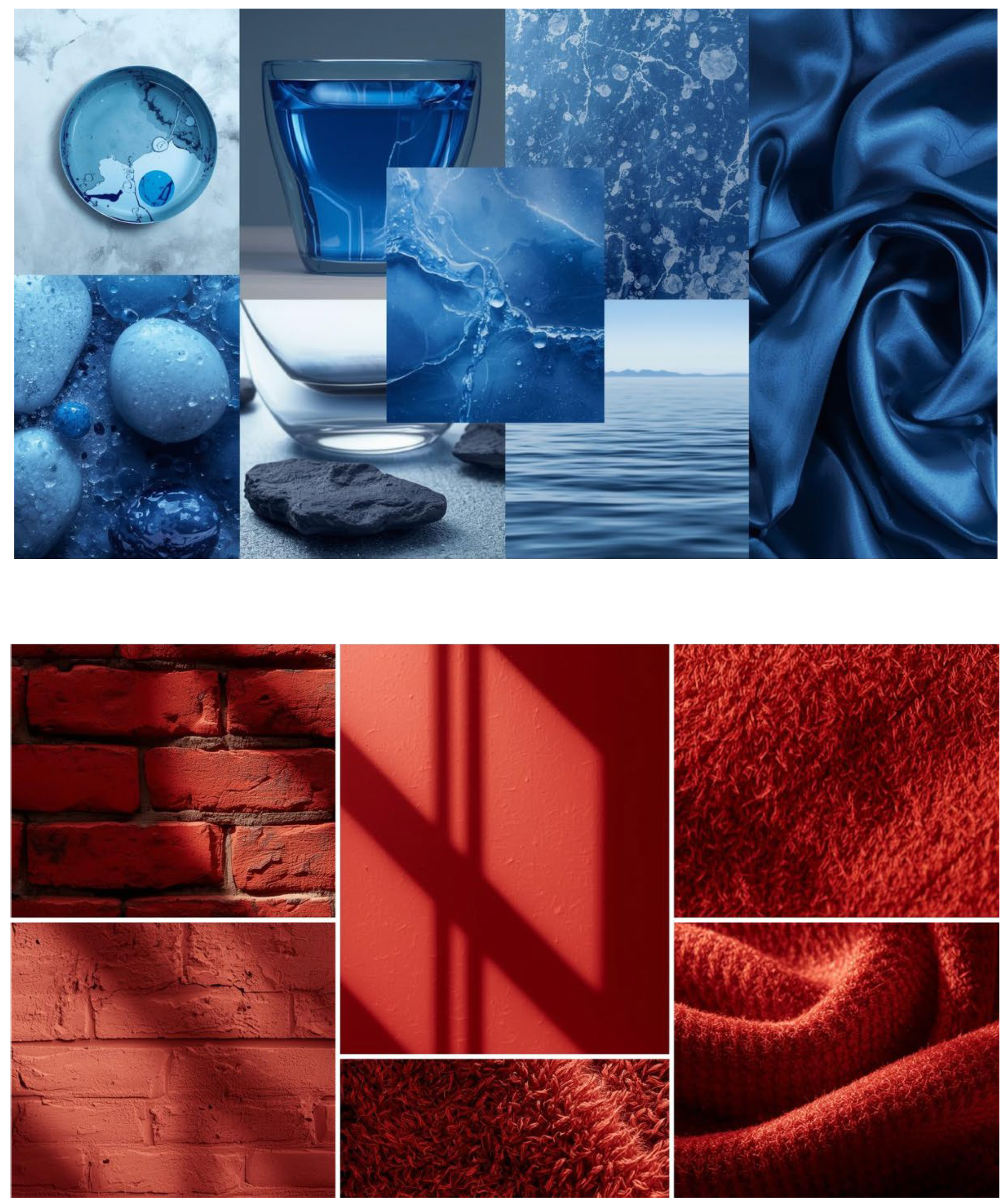
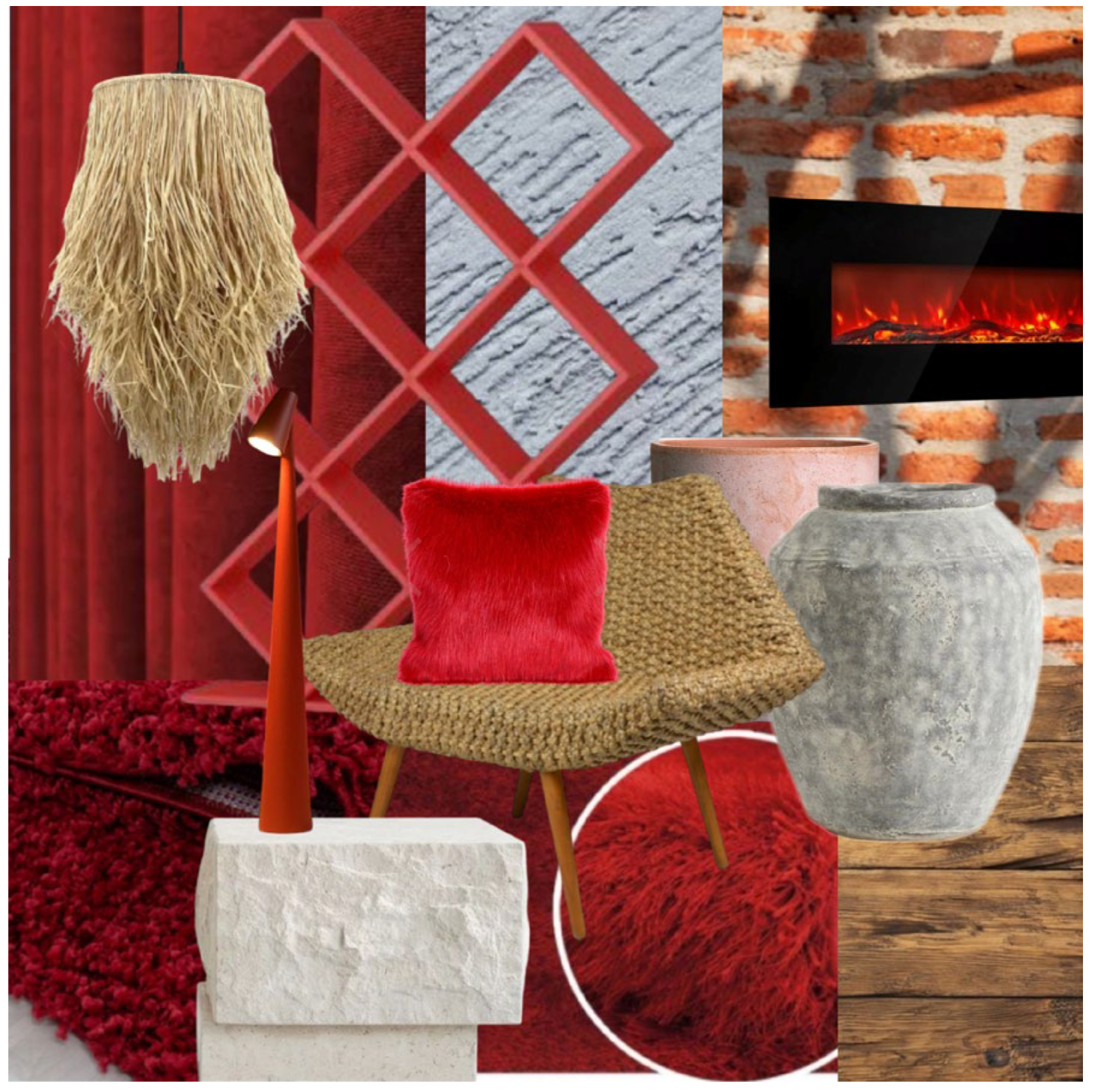

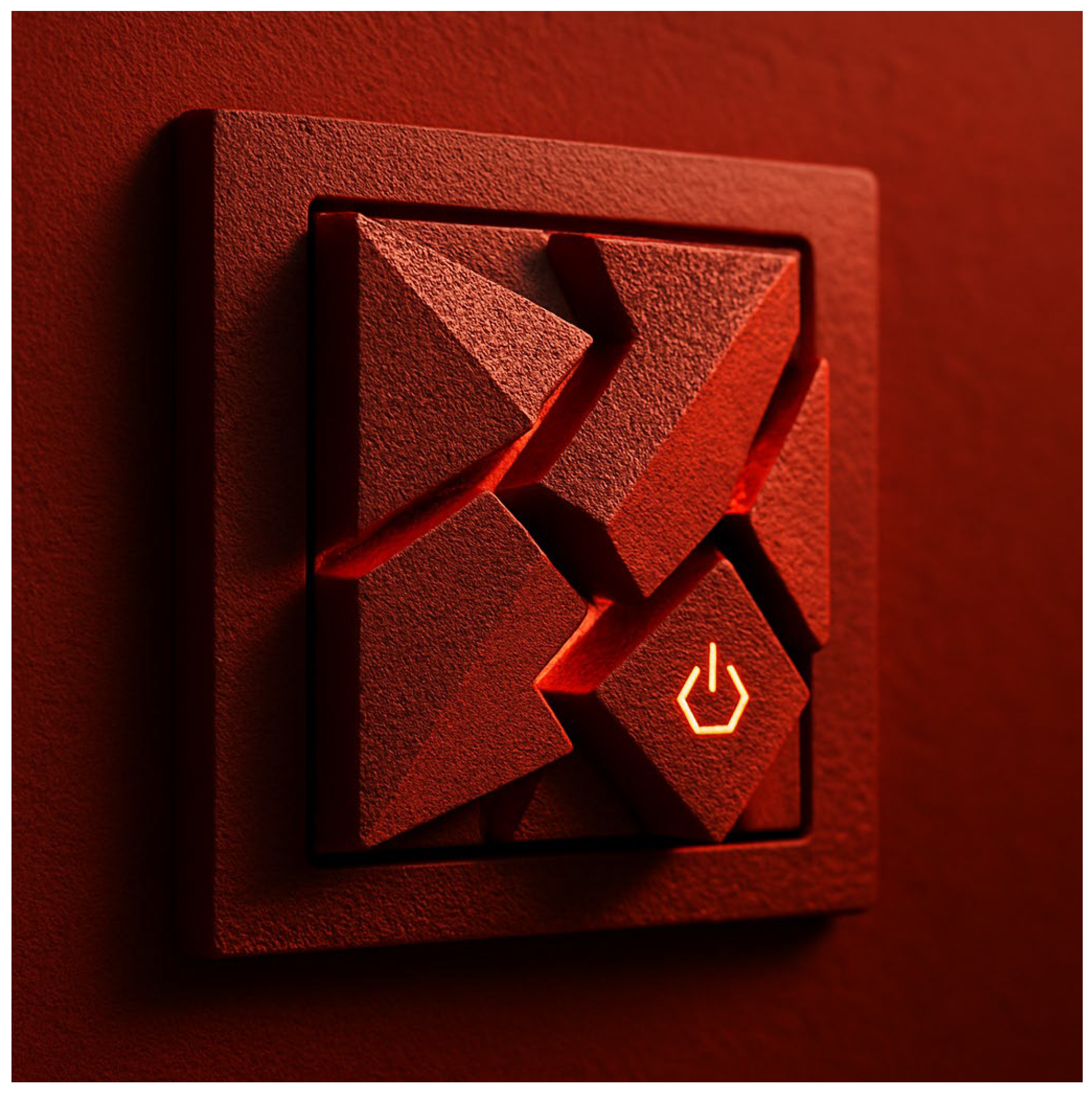

| Colors | Emotions Positive | Emotions Negative | Level of Arousal | Comments | |
|---|---|---|---|---|---|
| 1. | red | X love | X anger | TALL | Strong emotional reaction, ambiguous |
| 2. | yellow | X joy | TALL | Associated with optimism and light | |
| 3. | orange | X enthusiasm | TALL | Energizing, but not as aggressive as red | |
| 4. | blue | X composure | SHORT | It creates a feeling of security | |
| 5. | green | X relaxation | SHORT | It is associated with nature and harmony | |
| 6. | white | X cleanliness, openness | SHORT | Neutral, clean, soothing | |
| 7. | pink | X sensitivity | SHORT | Delicate, gentle, feminine | |
| 8 | purple | X strength, spirituality | TALL | It represents dignity, prestige, spirituality | |
| 9 | gray | X sadness | SHORT | Most often associated with melancholia | |
| 10 | black | X fear, sadness | TALL | The color of strong negative emotions |
| Colors | Correlated Tactile Property | Examples of Materials/Surfaces | Notes/Source |
|---|---|---|---|
| yellow | Soft, fluffy, delicate | Blanket, wool, velvet, MW foam | felt yellow when touched by a soft blanket/Ward & Simner, 2013 [25] |
| red | Rough, grainy, slightly rough | Sandpaper, raw wood, string | Strong color reaction of MW to rough cardboards/Ward & Simner, 2013 [25] |
| dark green | Rough, fibrous | Carded fabrics, jute, natural fabrics | Subjectively perceived as a “grainy” color of touch |
| blue | Smooth, cool, wet or slippery | Glazed ceramics, metal, glass | Color often associated with smoothness and coolness/Wastiels et al., 2021 [23] |
| white | Loose, dry, light | Flour, powder, chalk | Fine-grained feeling, “neutral” touch/Ward & Simner, 2013 [25] |
| brown | Hard, stiff, massive | Wood, leather, cork | Associated with weight and stability |
| black | Hard, slippery, cold or unfriendly | Marble, polished stone, metal | Often correlated with hardness and cold/Ludden et al., 2020 [22] |
| pink | Smooth, soft, warm | Velvet, latex, silicone | Associated with pleasure and tactile comfort |
| Narrative Aspect | Red | Blue |
|---|---|---|
| Meaning in the description of the ocean—Life | pulsating matter, threatening force, emotional tension | Cold intelligence, otherness, mystery, cosmic chill |
| Emotional context of the characters | Moments of confrontation with the past, surges of emotion, fear, guilt | Pseudo-calm, superficial order, cold distance |
| Connection with the day cycle on Solaris | Red sun—warm, intense, dramatic light | Blue sun—cold, pale, indifferent sky |
| Symbolic space—Chaos | claustrophobia, dominance, heaviness | Order, openness, submission, lightness |
| Spatial Feature | Red | Blue |
|---|---|---|
| Lighting | Warm light, strong shadow contrasts | Cold light, hidden sources |
| Form | Sharp angles, chaotic arrangement, crowding | Fluid forms, rounded shapes, few elements |
| Material | Rough, coarse surfaces | Smooth, light-reflecting surfaces |
| Acoustics | Noise, echo, loud effects | Silence, muffled sounds |
| Olfactory perception | Sweet fragrance | No distinct scent, freshness |
| Tactile perception | Oppressiveness, warmth, narrowness | Lightness, spaciousness, coolness |
| Red Color | Blue Color |
| Warm light | Cold light |
| Chaotic, disorderly arrangement | Orderly layout |
| Geometric, sharp forms, angles | Liquid forms, waves, curves |
| Dense arrangement of elements, tightening space | Open space, few elements |
| The layering of elements makes the space tighten | Smooth, light-reflecting materials. Use of airy materials |
| Overwhelm effect, Shadow play—strong chiaroscuro contrasts | High room. Hidden light sources |
| Feeling warm | Feeling cold |
| Dynamic sound effects | Silence |
| Rough, rough surfaces | Cleanliness |
| Sweet scent | The smell of freshness |
| Aspekt | Red Color | Blue Color |
|---|---|---|
| Cultural symbolism | Energy, power, passion, insecurity; happiness (China, Japan); also mourning (e.g., name of the deceased in Buddhism) | Peace, wisdom, harmony, spirituality; mourning (Iran); professionalism (business, medicine in Western culture) |
| Effect emotional | Stimulation, excitement, increased dynamics. Increases energy and activity levels. May cause anxiety if consumed in excess. | Calming, relaxation, contemplation. Reduces the level of stress and tension. It may contribute to a slight depression of mood (symbolism of sadness). |
| Perception of space | It optically reduces and zooms in on the walls (“pressing” color). It gives coziness, but too much of a feeling of claustrophobia | Optically, it enlarges and recedes the borders (“receding” color). It gives the impression of spaciousness and depth. It eliminates claustrophobia in small interiors. |
| Thermal comfort-feeling | “Warm”—subjectively increases the feeling of ambient temperature. The interior feels hotter; a color associated with fire and the sun | “Cold”—subjectively reduces the feeling of temperature. The interior feels cooler; a color associated with water and ice |
| Acoustics-noise | It enhances the perception of loudness—sounds seem louder and more insistent in a red environment | Softens the perception of loudness—noise is perceived as slightly quieter and less bothersome in a blue-green environment |
| Taste-smell | Sweet, intense—associated with ripe fruit, spices, flowers (rose). Red in the environment can stimulate appetite | Fresh, clean—associated with mint, air, water (sea breeze). Blue in the environment often suppresses appetite |
| Touch, texture-associations | Warm, rough—in synesthetic sensations, it may be associated with the impression of warmth, roughness or greater weight. | Cool, smooth—combined with the impression of coolness, smoothness and lightness. Often described as “lighter” and softer than red. |
| Sensory Modality | Red Code (Stimulation and Intensity) | Blue Flow (Calmness and Balance) |
|---|---|---|
| Form and layout | Sharp, geometric, layered buttons (triangles, rhombuses, jagged edges) | Smooth, flowing, wavy shapes reminiscent of water ripples |
| Surface texture | Rough, tactile, sandblasted or ceramic with grooves | Glossy, sleek, polished glass/ceramic with seamless finish |
| Thermal perception | Warm to the touch (wood, ceramic with micro-heating, warm polymers) | Cool to the touch (glass, stone, polished ceramic) |
| Color and lighting | Dark red casing, warm LED backlight (2700 K) highlighting contrasts | Light-to-medium blue casing, cool LED backlight (5000–6500 K) accentuating softness |
| Touch | Distinct roughness and warmth | Smoothness, gloss, coolness |
| Sight | Strong light–shadow contrasts, intense presence | Gentle reflections, soft contours, calming openness |
| Sound | Sharp, mechanical click sound | Muted, low-pitched click sound |
| Aspekt | Interior Model—“Cold and Ethereal” Variant | Conceptual Interior Model—“Chaotic and Overwhelming” Variant |
|---|---|---|
| 1. Lighting | Cold light (color temperature 5000–6500 K, white with a bluish tint). Concealed light sources (linear fixtures integrated into suspended ceilings, wall recesses, and floor-embedded strips). Light reflections enhanced by smooth, reflective surfaces. | Warm light (2700–3000 K, yellowish tones). The play of chiaroscuro-strong contrasts of light and dark zones. Spot lighting, local lighting, bringing out sharp forms. |
| 2. Form and Geometry | Fluid lines, waves, and curves expressed in ceilings, furniture, and details. A minimalist layout characterized by a small number of elements, emphasizing emptiness and airiness. Open space—absence of divisions and unnecessary partition walls. | Chaotic, disorderly arrangement-lack of alignment and compositional order. Geometric, sharp forms and angles-aggressive, irregular shapes. Density of elements-a feeling of limited, stuffy space. Layering-overlapping of forms, multiplication of shapes, impaired legibility of space. |
| 3. Materials and Textures | Smooth surfaces (lacquered finishes, glass, polished stone, metal). Light, airy materials—semi-transparent textiles (voile, organza, mesh fabrics). Reflectivity—glass and polished surfaces reinforcing the sense of coolness. | Rough, rough surfaces (concrete, raw wood, brick, unpolished stone). No gloss, light absorbing materials. Variety of textures creating anxiety and tactile contrasts, textures soft, warm to the touch |
| 4. Spatial Scale | A high ceiling conveying monumentality and spaciousness. Selected elements emphasizing verticality and lightness. | The space is getting tighter-walls, furniture and details are densely arranged, the feeling of being overwhelmed. A feeling of weight and confinement. |
| 5. Sensory Impressions | Touch: cold, smooth, and hard surfaces (glass, stone). Acoustics: silence, with reverberation moderated by discreet acoustic treatments, absence of disturbances. Smell: freshness—e.g., ozonic, marine, or citrus notes. Thermal sensation: low temperature and a perception of coolness enhanced by light color, chromatic palette (white, blues, silver). | The space is getting tighter-walls, furniture and details are densely arranged, the feeling of being overwhelmed. A feeling of weight and confinement. Touch: roughness, unevenness. Hearing: dynamic sound effects-echo, reverberation, sudden acoustic contrasts (e.g., sounds reflected from hard surfaces). Smell: sweet smell (association of intensity, heaviness of the atmosphere). Thermal perception: feeling of warmth enhanced by the color of light and materials. |
Disclaimer/Publisher’s Note: The statements, opinions and data contained in all publications are solely those of the individual author(s) and contributor(s) and not of MDPI and/or the editor(s). MDPI and/or the editor(s) disclaim responsibility for any injury to people or property resulting from any ideas, methods, instructions or products referred to in the content. |
© 2025 by the authors. Licensee MDPI, Basel, Switzerland. This article is an open access article distributed under the terms and conditions of the Creative Commons Attribution (CC BY) license (https://creativecommons.org/licenses/by/4.0/).
Share and Cite
Rek-Lipczyńska, A.; Kowalska, A. Multisensory Coding of Red and Blue in Interior Design for Older Adults and Visually Impaired Users: An Inclusive Design Perspective. Sustainability 2025, 17, 9381. https://doi.org/10.3390/su17219381
Rek-Lipczyńska A, Kowalska A. Multisensory Coding of Red and Blue in Interior Design for Older Adults and Visually Impaired Users: An Inclusive Design Perspective. Sustainability. 2025; 17(21):9381. https://doi.org/10.3390/su17219381
Chicago/Turabian StyleRek-Lipczyńska, Agnieszka, and Aleksandra Kowalska. 2025. "Multisensory Coding of Red and Blue in Interior Design for Older Adults and Visually Impaired Users: An Inclusive Design Perspective" Sustainability 17, no. 21: 9381. https://doi.org/10.3390/su17219381
APA StyleRek-Lipczyńska, A., & Kowalska, A. (2025). Multisensory Coding of Red and Blue in Interior Design for Older Adults and Visually Impaired Users: An Inclusive Design Perspective. Sustainability, 17(21), 9381. https://doi.org/10.3390/su17219381






